Study on the Impact of the Export of China’s Final Use Products on Domestic SO2 Emissions
Abstract
:1. Introduction
2. Methods and Data Sources
2.1. Basic Input–Output Model
2.2. Structural Decomposition Analysis (SDA)
2.3. Data Sources
3. Results and Discussions
3.1. Analysis of the Overall SO2 Emissions Caused by the ECFuP
3.1.1. Analysis of the ECFuP and SO2 Emissions from the Overall Perspective
3.1.2. Structural Decomposition Analysis (SDA) from the Overall Perspective
3.2. Analysis of the ECFuP and SO2 Emissions from the Regional Perspective
3.3. Analysis of the ECFuP and SO2 Emissions from the Industrial Perspective
4. Conclusions and Recommendations
Author Contributions
Funding
Conflicts of Interest
References
- National Bureau of Statistics of China. 2019. Available online: http://data.stats.gov.cn/easyquery.htm?cn=C01 (accessed on 17 October 2019).
- Li, C.; Mclinden, C.; Fioletov, V.; Krotkov, N.; Carn, S.; Joiner, J.; Streets, D.; He, H.; Ren, X.; Li, Z. India is overtaking China as the world’s largest emitter of anthropogenic sulfur dioxide. Sci. Rep. 2017, 7, 14304. [Google Scholar] [CrossRef] [PubMed]
- Muradian, R.; Martinez-Alier, J. Trade and the environment: From a ‘Southern’ perspective. Ecol. Econ. 2001, 36, 281–297. [Google Scholar] [CrossRef]
- Wu, S.M.; Lei, Y.L.; Li, L. Resource distribution, interprovincial trade, and embodied energy: A case study of China. Adv. Mater. Sci. Eng. 2015, 2015, 910835. [Google Scholar] [CrossRef]
- Li, Q.; Wu, S.; Lei, Y.; Li, S.; Li, L. China’s provincial CO2 emissions and interprovincial transfer caused by investment demand. Environ. Sci. Pollut. Res. Int. 2019, 26, 312–325. [Google Scholar] [CrossRef] [PubMed]
- Ling, J.; Feng, W.; Wei, Z.; Yu, L.; Tian, Y. Research of fairness of inter-provincial air pollution governance input based on trade-embodied environment cost and economic benefits trade-off: A case study of Pan-Beijing-Tianjin-Hebei region. Urban Dev. Stud. 2017, 10, 72–80. [Google Scholar]
- Feng, W.; Liu, B.; Bing, Z. Embodied environmental damage in interregional trade: A MRIO-based assessment within China. J. Clean. Prod. 2016, 140, 1236–1246. [Google Scholar]
- Kanemoto, K.; Moran, D.; Lenzen, M.; Geschke, A. International trade undermines national emission reduction targets: New evidence from air pollution. Glob. Environ. Chang. 2014, 24, 52–59. [Google Scholar] [CrossRef]
- Zhao, H.Y.; Zhang, Q.; Guan, D.; Davis, S.J.; Liu, Z.; Huo, H.; Lin, J.T.; Liu, W.D.; He, K.B. Corrigendum to “Assessment of China’s virtual air pollution transport embodied in trade by using a consumption-based emission inventory”. Atmos. Chem. Phys. 2015, 15, 6815. [Google Scholar] [CrossRef]
- Zhao, H.Y.; Zhang, Q.; Huo, H.; Lin, J.T.; Liu, Z.; Wang, H.K.; Guan, D.B.; He, K.B. Environment-economy tradeoff for Beijing-Tianjin-Hebei’s exports. Appl. Energy 2016, 184, 926–935. [Google Scholar] [CrossRef]
- Cong, X.; Wang, Z.; Guo, X. The calculation of carbon dioxide emissions embodied in global trade and the analysis of geopolinomic structure. J. Financ. Econ. 2013, 39, 112–121. [Google Scholar]
- Davis, S.J.; Caldeira, K. Consumption-based accounting of CO2 emissions. Proc. Natl. Acad. Sci. USA 2010, 107, 5687–5692. [Google Scholar] [CrossRef] [PubMed]
- Ni, H. Calculation of CO2 embodied in international trade and structural green transformation. China Popul. Resour. Environ. 2012, 22, 164–169. [Google Scholar]
- Mi, Z.; Meng, J.; Guan, D.; Shan, Y.; Liu, Z.; Wang, Y.; Feng, K.; Wei, Y.M. Pattern changes in determinants of Chinese emissions. Environ. Res. Lett. 2017, 12, 074003. [Google Scholar] [CrossRef]
- Meng, J.; Mi, Z.; Guan, D.; Li, J.; Tao, S.; Li, Y.; Feng, K.; Liu, J.; Liu, Z.; Wang, X.; et al. The rise of South–South trade and its effect on global CO2 emissions. Nat. Commun. 2018, 9, 1871. [Google Scholar] [CrossRef]
- Gu, A.; He, J.; Zhou, L.; Yao, L.; Liu, B. Analysis of embodied energy and transfer emissions of China’s import and export trade. J. Tsinghua Univ. Sci. Technol. 2010, 50, 1456–1459. [Google Scholar]
- Kahrl, F.; Roland-Holst, D. Energy and exports in China. China Econ. Rev. 2008, 19, 649–658. [Google Scholar] [CrossRef]
- Ming, X.; Braden, A.; Chen, W. Energy and air emissions embodied in China-U.S. trade: Eastbound assessment using adjusted bilateral trade data. Environ. Sci. Technol. 2009, 43, 3378–3384. [Google Scholar]
- Li, Y.; Zhang, W.; Jiang, H.; Wang, F.; Hou, L.; Wang, J. Transfers of air pollutant emissions embodied in China’s foreign trade based on MRIO model. China Environ. Sci. 2019, 39, 889–896. [Google Scholar]
- Dugu, C.H.; Wu, X.; Zhou, X.L. The analysis of pollution emission embodied in China-US trade and their determinants. Shanghai J. Econ. 2015. Available online: http://www.cnki.com.cn/Article/CJFDTotal-HSYJ201507013.htm (accessed on 17 October 2019).
- Huang, Y.; Chen, X. Transfer of embodied pollution of China’s trade. China Popul. Resour. Environ. 2018, 28, 112–120. [Google Scholar]
- Shen, L.S.; Tang, Z. The effect of foreign trade on China’s discharge of pollutants. Manag. World 2008, 6, 21–29. [Google Scholar]
- Pang, J.; Shi, Y.C.; Tao, H.U.; Yan, Y.N.; Liang, L.N. Structural decomposition analysis of pollutants emission change embodied in exports of China. China Environ. Sci. 2013, 33, 2274–2285. [Google Scholar]
- Deng, R. Embodied SO2 emission in China’s Foreign Trade—An analysis based on non-competitive (import) input-output tables. J. Univ. South. China 2014, 15, 44–52. [Google Scholar]
- Ni, H.; Li, S.; He, J. Measurement of embodied SO2 and structural decomposition analysis of the factors. Stat. Res. 2012, 29, 54–60. [Google Scholar]
- Xu, S.C.; Zhang, W.W.; Li, Q.B.; Zhao, B.; Wang, S.X.; Long, R.Y. Decomposition analysis of the factors that influence energy related air pollutant emission changes in China using the SDA method. Sustainability 2017, 9, 1742. [Google Scholar] [CrossRef]
- Liu, Q.; Wang, Q. Reexamine SO2 emissions embodied in China’s exports using multiregional input–output analysis. Ecol. Econ. 2015, 113, 39–50. [Google Scholar] [CrossRef]
- Feng, T.; Zhao, H.Y.; Zhang, Q. Global sulfur dioxide emissions in multiple input-output perspectives. Acta Sci. Circumstantiae 2017, 37, 1209–1215. [Google Scholar]
- Chen, Y.Y.; Li, Y.N.; Yan, J. Tracing air pollutant emissions in China: Structural decomposition and GVC accounting. Sustainability 2019, 11, 2551. [Google Scholar] [CrossRef]
- Jun, P. Energy and Environmental Input-Output Analysis Model, Method and Application; Economic Science Press: Beijing, China, 2016. [Google Scholar]
- Peters, G.P.; Hertwich, E.G. The importance of imports for household environmental impacts. J. Ind. Ecol. 2010, 10, 89–109. [Google Scholar] [CrossRef]
- Park, H.C.; Eunnyeong, H. The direct and indirect household energy requirements in the Republic of Korea from 1980 to 2000—An input–output analysis. Energy Policy 2007, 35, 2839–2851. [Google Scholar] [CrossRef]
- Yan, Z.; Zheng, H.; Yang, Z.; Su, M.; Liu, G.; Li, Y. Multi-regional input–output model and ecological network analysis for regional embodied energy accounting in China. Energy Policy 2015, 86, 651–663. [Google Scholar]
- Liang, Q.M.; Fan, Y.; Wei, Y.M. Multi-regional input-output model for regional energy requirements and CO2 emissions in China. Energy Policy 2007, 35, 1685–1700. [Google Scholar] [CrossRef]
- National Bureau of Statistics of China, Ministry of Environmental Protection. China Statistical Yearbook on Environment; China Statistics Press: Beijing, China, 2004–2012.
- World Input-Output Database. 2004–2012. Available online: http://www.wiod.org/database/riots13 (accessed on 17 October 2019).
- National Bureau of Statistics of China. China Statistical Yearbook; China Statistics Press: Beijing, China, 2018.
- Huang, R. The Development of EMRICES+ and Its Simulation Research on China’s Collaborative Reduction Policies. Ph.D. Thesis, East China Normal University, Shanghai, China, 2014. [Google Scholar]
- Wu, S.; Wu, Y.; Lei, Y.; Li, S.; Li, L. Chinese provinces’ CO2 emissions embodied in imports and exports. Earth’s Future 2018, 6, 867–881. [Google Scholar] [CrossRef]
- Mi, Z.; Meng, J.; Green, F.; Coffman, D.M.; Guan, D. China’s “exported carbon” peak: Patterns, drivers, and implications. Geophys. Res. Lett. 2018, 45, 4309–4318. [Google Scholar] [CrossRef]
- Ministry of Commerce of the People’s Republic of China. Report on China’s Foreign Trade Situation (Spring 2019); General Department of the Ministry of Commerce: Beijing, China, 2019.
- Sun, Z.F. The impact of north American free trade area on China’s economic development. Spec. Zone Econ. 2008. Available online: http://www.cnki.com.cn/Article/CJFDTotal-TAJJ200803034.htm (accessed on 17 October 2019).
- Xu, Y.Z. Research on the Issues of Building Free Trade Zone Between China and Russia. Ph.D. Thesis, Jilin University, Jilin, China, 2016. [Google Scholar]
- Chi, Y. The impact of China-Australia free trade area on China’s agricultural products export. China Bus. Trade 2014, 32, 123–124. [Google Scholar]
- Zhang, Z. Study on the Economic Effect of the Establishment of China-India Free Trade Zone. Master’s Thesis, Yunnan University of Finance and Economics, Yunnan, China, 2017. [Google Scholar]
- Kun, M. The status quo, constraints and countermeasures of China’s textile exports. Heilongjiang Foreign Econ. Relat. Trade 2014. Available online: https://www.docin.com/p-1214429310.html (accessed on 17 October 2019).
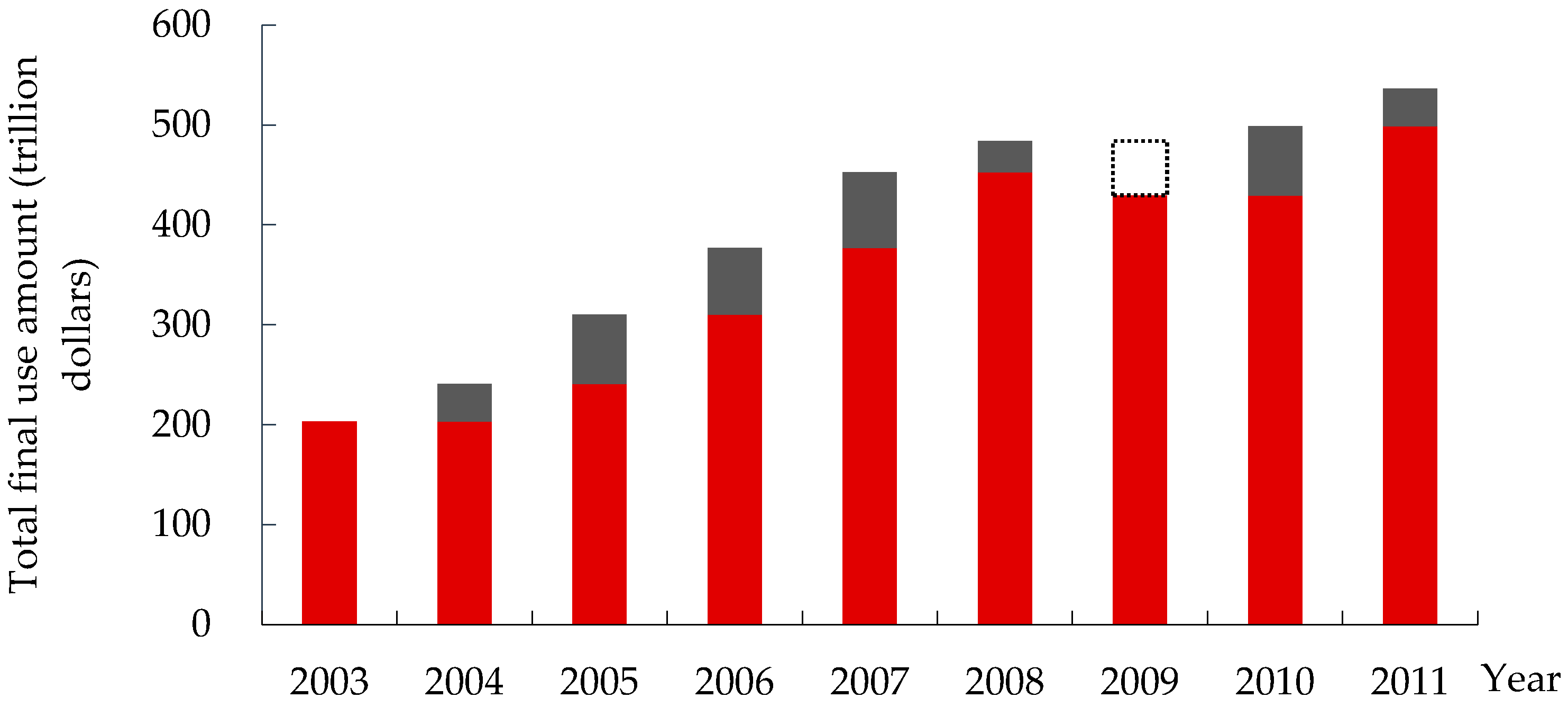
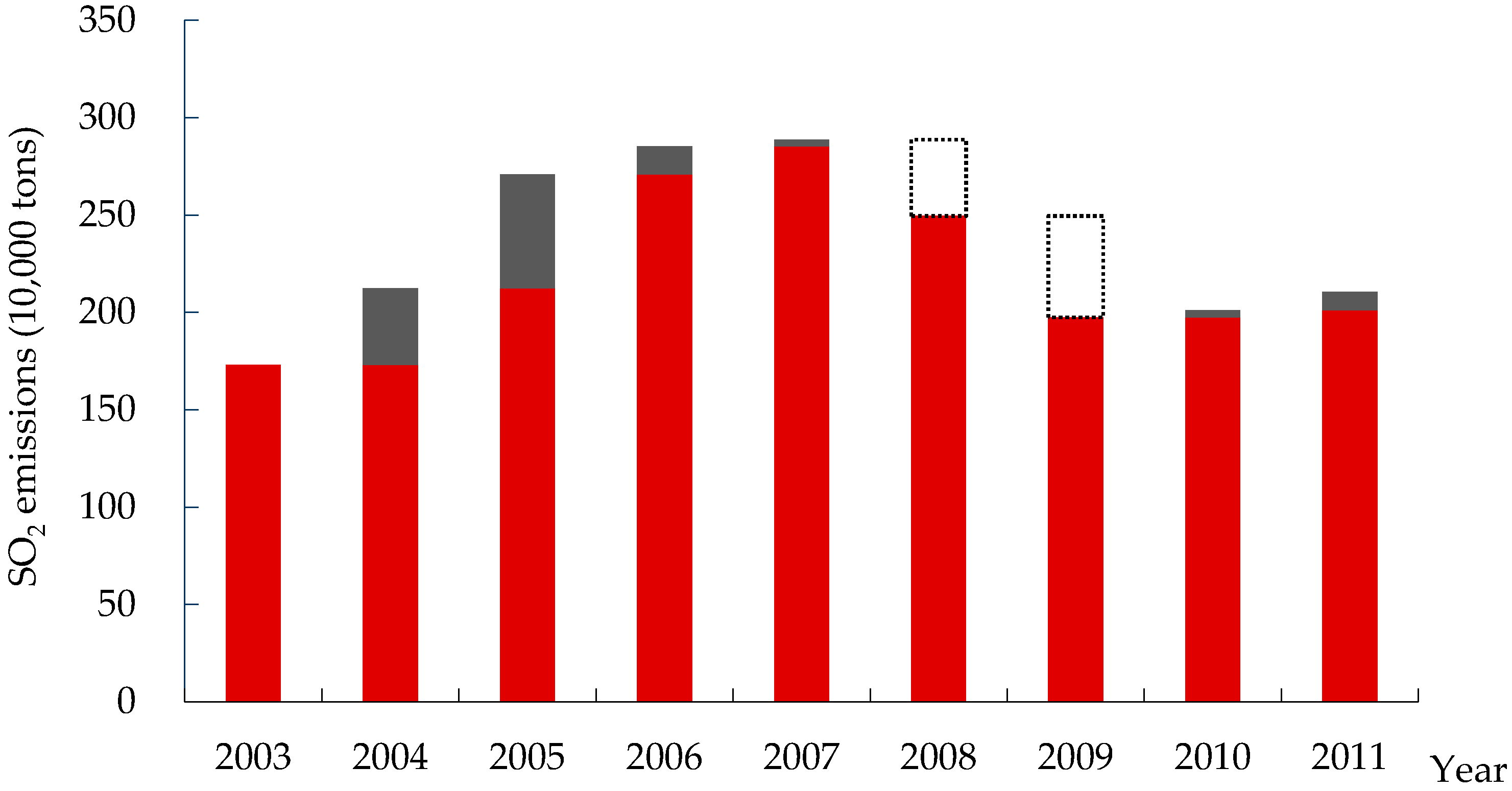

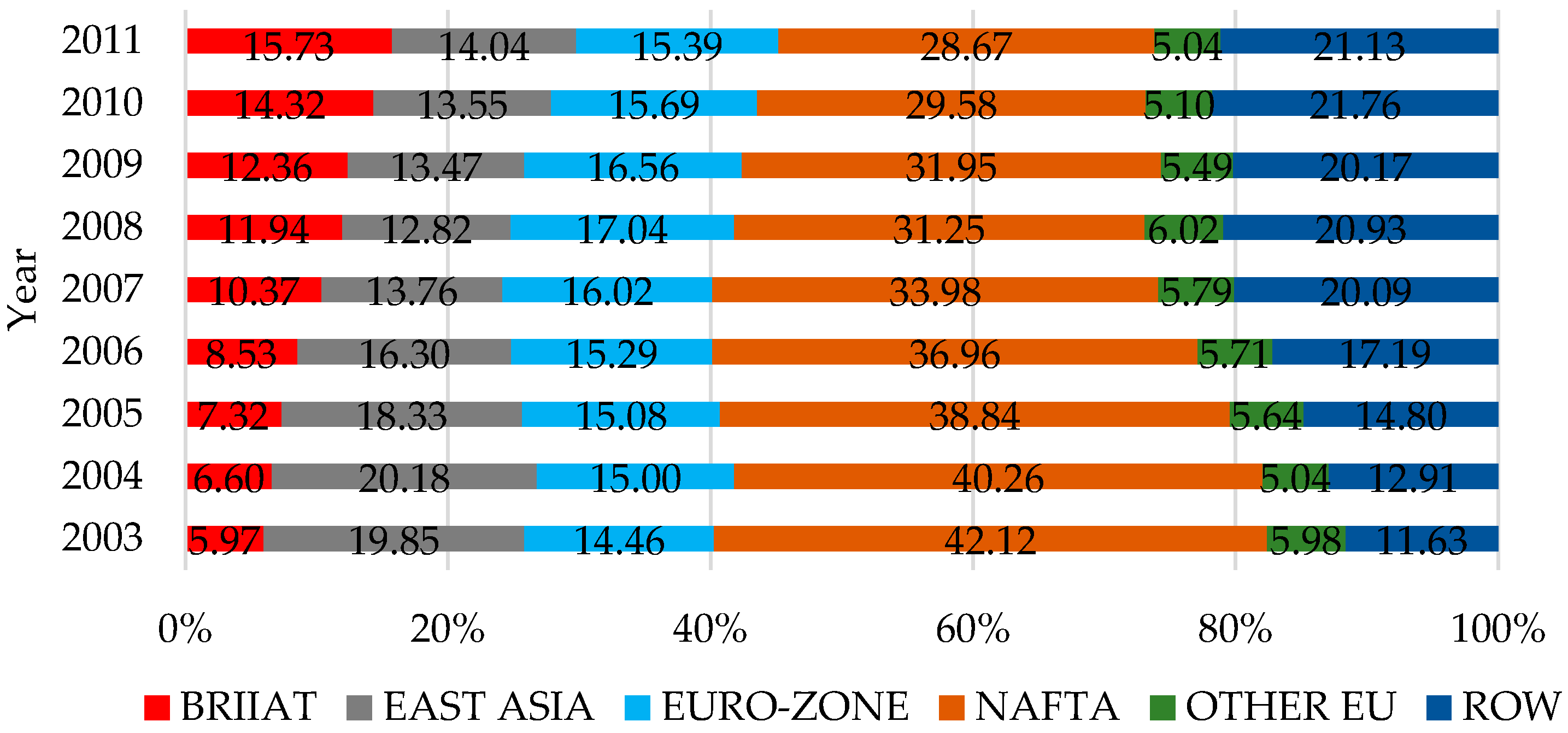
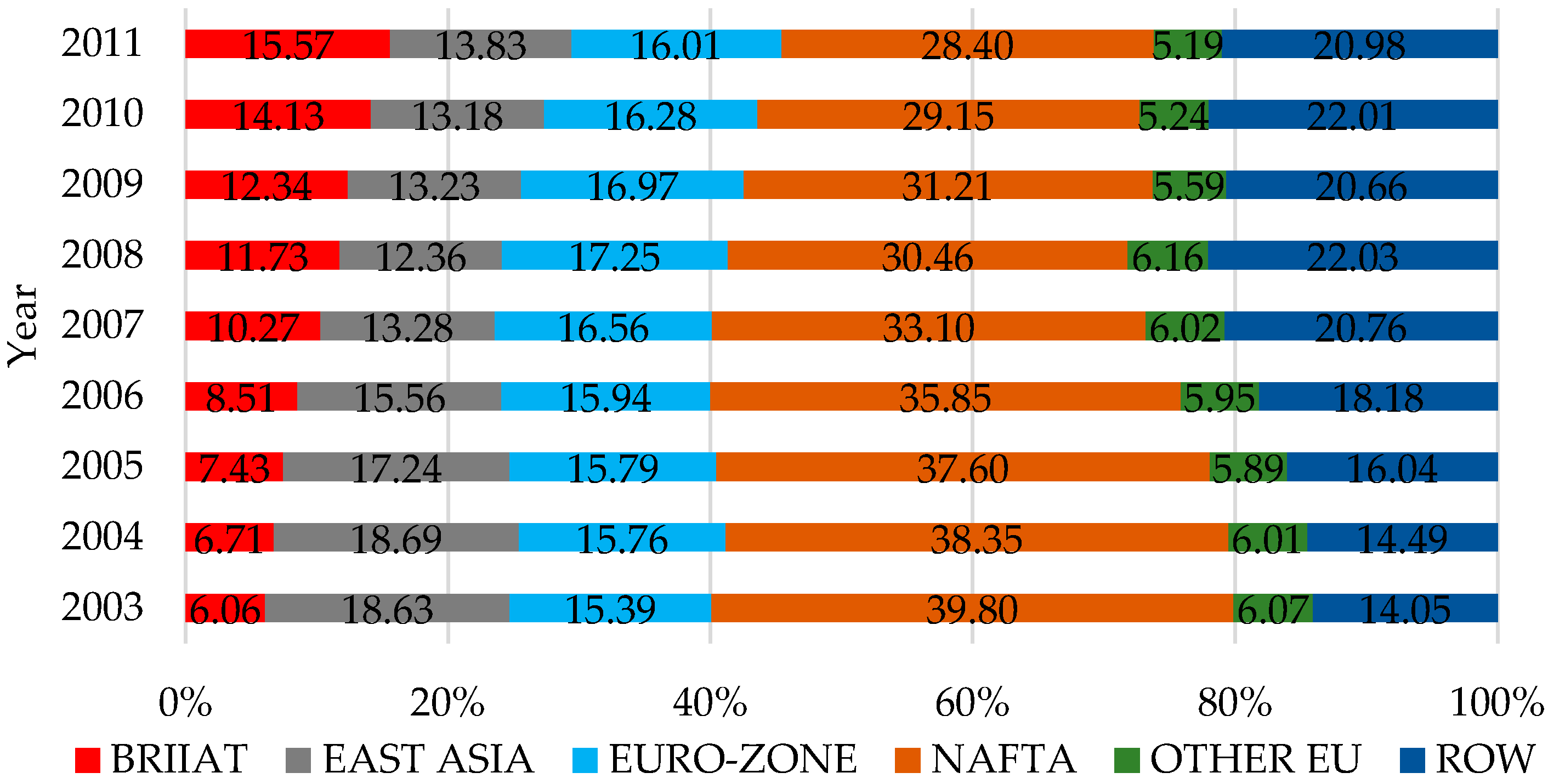
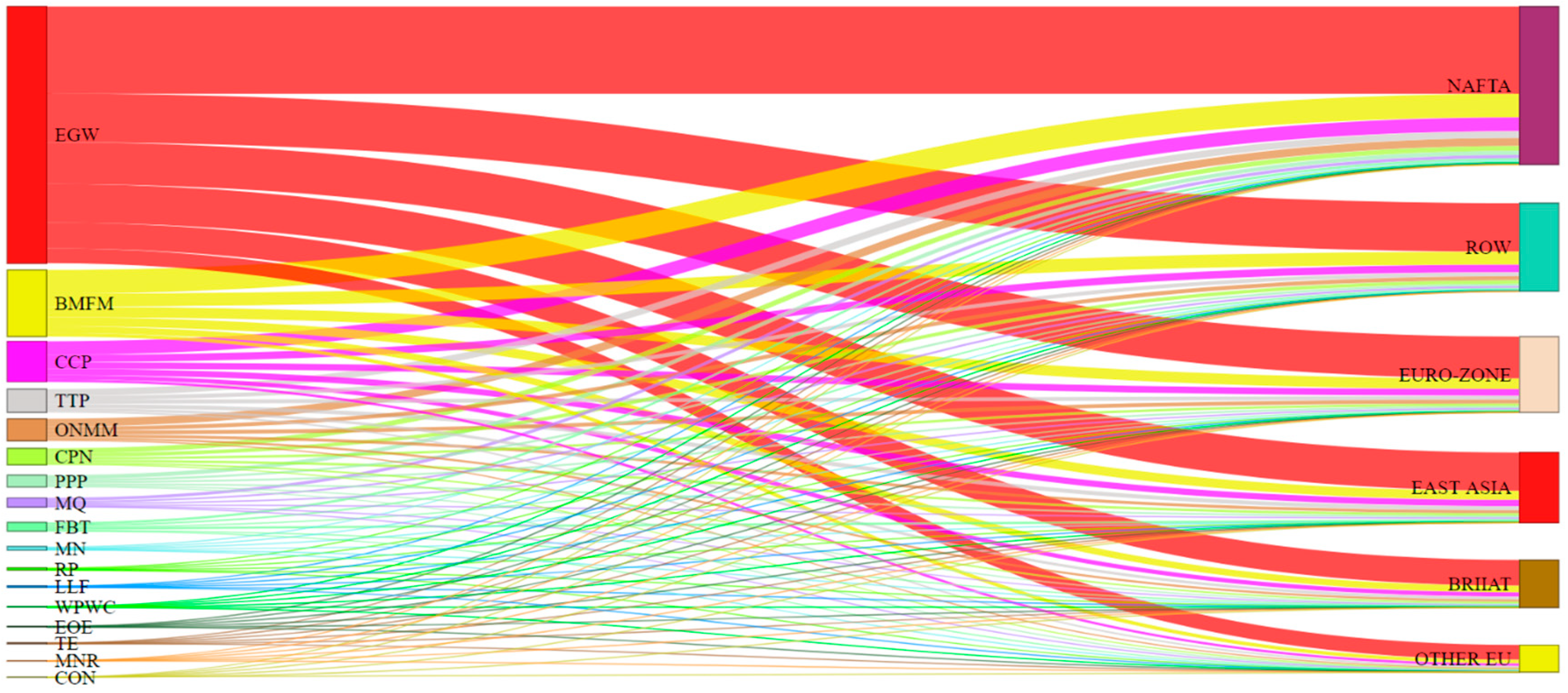
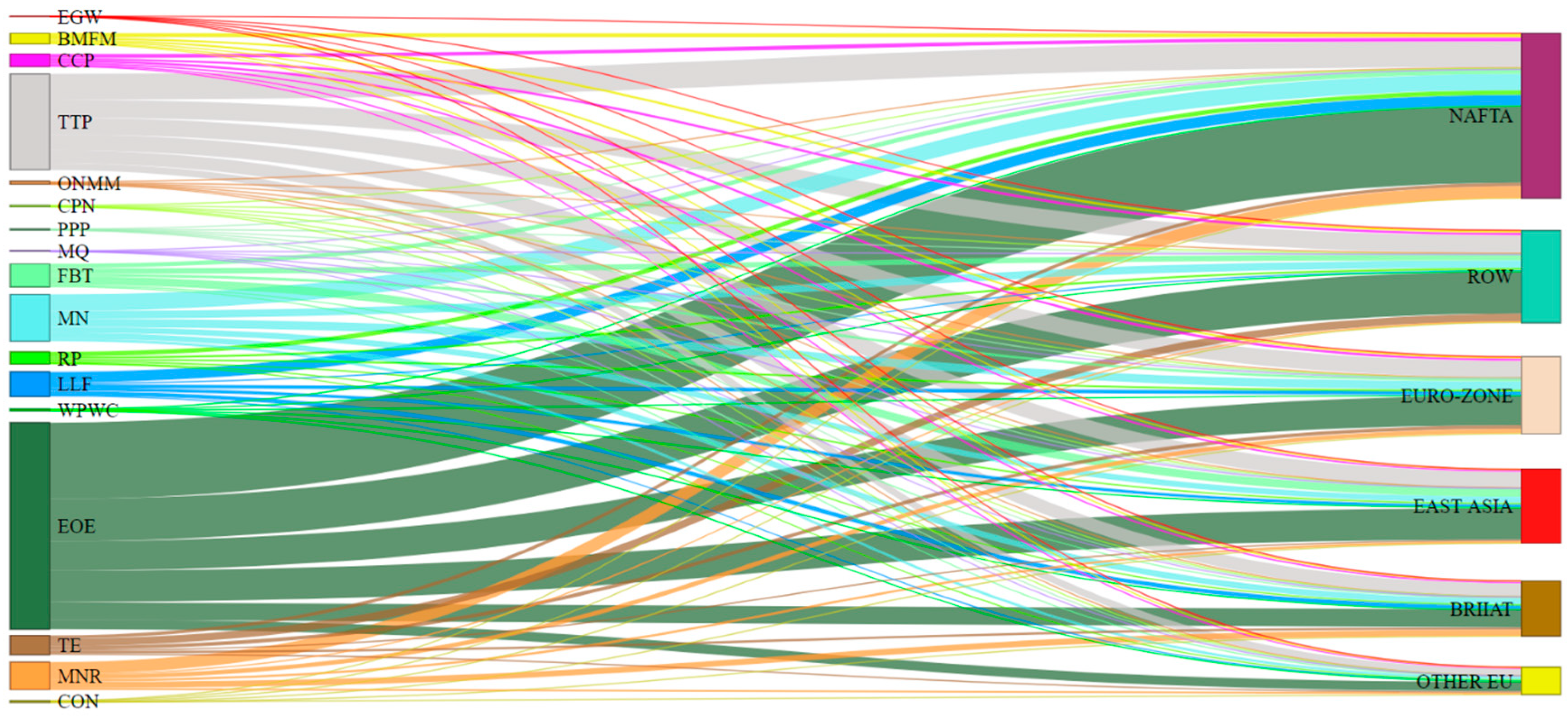
| Intermediate Demand | Final Demand | Total Output | Industrial SO2 Emissions | ||||||||
|---|---|---|---|---|---|---|---|---|---|---|---|
| Region 1 | Region 2 | … | Region m | Region 1 | Region 2 | … | Region m | ||||
| Intermediate input | Region 1 | x11 | x12 | … | x1m | Y11 | Y12 | … | Y1m | X1 | S1 |
| Region 2 | x21 | x22 | … | x2m | Y21 | Y22 | … | Y2m | X2 | S2 | |
| … | … | … | … | … | … | … | … | … | … | … | |
| Region m | xm1 | Xm2 | … | Xmm | Ym1 | Ym2 | … | Ymm | Xm | Sm | |
| Value added | V1 | V2 | … | Vm | |||||||
| Total input | X1T | X2T | … | XmT | |||||||
| No. | Interregional Input–Output Table | China Statistical Yearbook on Environment |
|---|---|---|
| 1 | Mining and Quarrying (MQ) | Mining and Washing of Coal; Extraction of Petroleum and Natural Gas; Mining and Processing of Ferrous Metal Ores; Mining and Processing of Non-ferrous Metal Ores; Mining and Processing of Nonmetal Ores; Mining of Other Ores; Ancillary Activities for Exploitation |
| 2 | Food, Beverages, and Tobacco (FBT) | Processing of Food from Agricultural Products; Manufacture of Foods; Manufacture of Wine, Drinks and Refined Tea; Manufacture of Tobacco |
| 3 | Textiles and Textile Products (TTP) | Manufacture of Textile; Manufacture of Textile Wearing and Apparel |
| 4 | Leather, Leather, and Footwear (LLF) | Manufacture of Leather, Fur, Feather and Related Products and Footwear |
| 5 | Wood and Products of Wood, and Cork (WPWC) | Processing of Timber, Manufacture of Wood, Bamboo, Rattan, Palm, and Straw Products; Manufacture of Furniture |
| 6 | Pulp, Paper, Paper Printing, and Publishing (PPP) | Manufacture of Paper and Paper Products; Printing, Reproduction of Recording Media; Manufacture of Articles for Culture, Education and Sport Activity |
| 7 | Coke, Refined Petroleum and Nuclear Fuel (CPN) | Processing of Petroleum, Coking, Processing of Nuclear Fuel |
| 8 | Chemicals and Chemical Products (CCP) | Manufacture of Raw Chemical Materials and Chemical Products; Manufacture of Medicines; Manufacture of Chemical Fibers |
| 9 | Rubber and Plastics (RP) | Manufacture of Rubber; Manufacture of Plastics |
| 10 | Other Non-Metallic Mineral (ONMM) | Manufacture of Non-metallic Mineral Products |
| 11 | Basic Metals and Fabricated Metal (BMFM) | Smelting and Pressing of Ferrous Metals; Smelting and Pressing of Non-ferrous Metals; Manufacture of Metal Products |
| 12 | Machinery, Nec (MN) | Manufacture of General Purpose Machinery; Manufacture of Special Purpose Machinery; Manufacture of Communication Equipment, Computers and Other Electronic Equipment; Manufacture of Measuring Instruments and Machinery for Cultural Activity and Office Work; Manufacture of Artwork and Other Manufacturing; Metal Products, Machinery and Equipment Repair; Other Manufactures |
| 13 | Electrical and Optical Equipment (EOE) | Manufacture of Electrical Machinery and Equipment |
| 14 | Transport Equipment (TE) | Manufacture of Automobile; Manufacture of Railway, Shipbuilding, Aerospace and Other Transportation Equipment |
| 15 | Manufacturing, Nec; Recycling (MNR) | Recycling and Disposal of Waste (Utilization of Waste Resources) |
| 16 | Electricity, Gas, and Water Supply (EGW) | Production and Distribution of Electric Power and Heat Power; Production and Distribution of Gas; Production and Distribution of Water |
| 17 | Construction (CON) | Other Sectors |
© 2019 by the authors. Licensee MDPI, Basel, Switzerland. This article is an open access article distributed under the terms and conditions of the Creative Commons Attribution (CC BY) license (http://creativecommons.org/licenses/by/4.0/).
Share and Cite
Zang, Z.; Zhang, H.; Liu, H.; Wang, J.; Goetswang, K.F. Study on the Impact of the Export of China’s Final Use Products on Domestic SO2 Emissions. Sustainability 2019, 11, 5809. https://doi.org/10.3390/su11205809
Zang Z, Zhang H, Liu H, Wang J, Goetswang KF. Study on the Impact of the Export of China’s Final Use Products on Domestic SO2 Emissions. Sustainability. 2019; 11(20):5809. https://doi.org/10.3390/su11205809
Chicago/Turabian StyleZang, Zhenjie, Hua Zhang, Huifang Liu, Jun Wang, and Kealeboga Fredah Goetswang. 2019. "Study on the Impact of the Export of China’s Final Use Products on Domestic SO2 Emissions" Sustainability 11, no. 20: 5809. https://doi.org/10.3390/su11205809
APA StyleZang, Z., Zhang, H., Liu, H., Wang, J., & Goetswang, K. F. (2019). Study on the Impact of the Export of China’s Final Use Products on Domestic SO2 Emissions. Sustainability, 11(20), 5809. https://doi.org/10.3390/su11205809





